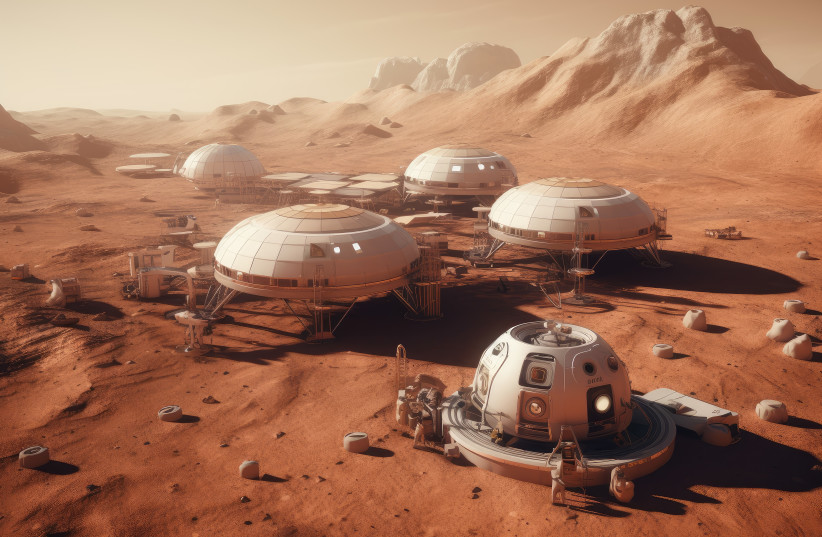At least 22 people would be needed to effectively operate a mining colony on Mars, according to a new, pre-print study published earlier this month by data scientists from George Mason University on the arXiv server.
The study, titled "An Exploration of Mars Colonization with Agent-Based Modeling," examined how a team sent to colonize Mars and mine minerals to send back to Earth would need to look in order to function well, using a computer simulation that somewhat mimics an RPG game.
With nations around the globe racing to expand the exploration of space, scientists are exploring how humans could survive on Mars and other planets for extended periods.
The team developed the model with the base assumptions that the colony itself will have already been constructed, with food, air, and water being produced locally, and that a nuclear generator will have already been installed at the site.
The scientists used a method known as agent-based modeling (ABM) to build their model, a method in which a system is analyzed from the bottom up in computer simulations by how individual agents interact with one another, with each agent assigned certain attributes.

The scientists noted that the model places an emphasis on the mental state of each member of the theoretical Martian colony, as that "directly impacts the success of the mission."
The study used previous research concerning the coping abilities of common personality types in stressful conditions and introduced random accidents such as habitat disasters and issues transporting food from Earth to activate "stressors" to test the members of the Martian team.
When triggered by a disaster or transport issue, the stressors either dissipate over time or are removed by the members of the Martian team if they succeed in a skills check to recover.
The model also examined how the members of the team interacted with the colony to produce, store, and consume resources, as well as how the environment led to habitat accidents, earth shipment issues, technological efficiency, and production skill requirements.
The scientists tested computer models with teams ranging from four to 152 members, with each model dividing the members of the team equally into four psychological categories: neurotic, reactive, social, and agreeable. The team members also received a skillset that determined their success in producing resources.
The teams were placed in a simulated colony represented by a 50x50 grid with each grid cell having an individual resource production capacity, but collective and unlimited storage.
As the model was run, the Martian team members were able to move, sleep, team up with other team members, produce or consume resources, and engage socially. The health of the team members was restored by sleeping. The team members in the computer model would perform skills checks to see if they could produce food, water, and air.
Each team member also had a weekly requirement for food, water, and air, with their health dropping if those requirements were not met. If the team member's health hit zero the member died and was removed from the model. There was additionally a small random chance of death for each Martian to represent unforeseen mortality.
At each step of the simulation, the simulation could add new team members, have an earth shipment be received by the colony, be lost in a disaster, or have a habitat accident take place. Habitat accidents would randomly affect either the food, water, air, or mineral resource supplies for the colony and reduce the affected resource by half.
The scientists used data from supply shipments and resource requirements on the International Space Station, as well as data from past experiments about teamwork in stressful situations such as in submarine teams to set the parameters for the model.
The scientists ran the model five times, simulating 28 Earth years, varying the initial population size from 10 to 170 by steps of 10. The scientists chose a team size of 10 as the minimum needed for a "stable" colony that could withstand disasters and produce enough resources.
22 members is the 'golden number' for a Mars team
The scientists found that a population size of 22 members was the minimum initial team required in order to maintain a viable colony size over an extended period. Any less than that, and the colony would risk being unable to recover if it fell under 10 members at any point.
Interestingly, a team of 26 members and a team of 38 members fell under ten members and failed to bounce back in the simulations, despite being above the 22-member minimum.
In all runs of the model, only team members with the "agreeable" personality type survived the full duration of the model runs. The scientists explained that this was likely because they were the best at coping with different situations and disasters.
Meanwhile, the "neurotic" personality type was the most likely to fail to survive, with the "reactive" and "social" personality types falling somewhere in the middle.
The scientists noted that while their model assigned an equal distribution of the different personality types among each team, a team consisting entirely of "agreeable" personality types could possibly be successful enough to be able to survive with a smaller than 10-member team.
The scientists stressed that their model did not address waste removal and on-site resource production, as their models found that even with shipping disasters, the colony would still be more than sufficiently resupplied with earth shipments. The scientists recommend examining these fields in future studies.
